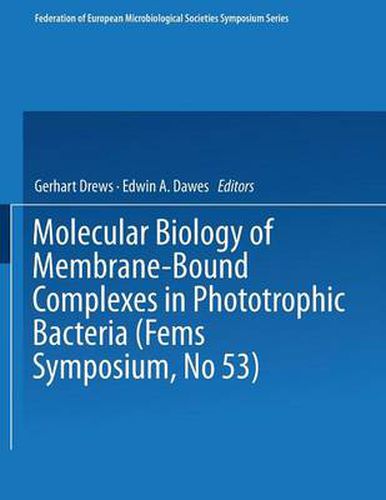Readings Newsletter
Become a Readings Member to make your shopping experience even easier.
Sign in or sign up for free!
You’re not far away from qualifying for FREE standard shipping within Australia
You’ve qualified for FREE standard shipping within Australia
The cart is loading…






This title is printed to order. This book may have been self-published. If so, we cannot guarantee the quality of the content. In the main most books will have gone through the editing process however some may not. We therefore suggest that you be aware of this before ordering this book. If in doubt check either the author or publisher’s details as we are unable to accept any returns unless they are faulty. Please contact us if you have any questions.
Cells of phototrophic bacterla are fitted out with a characteristic and sometimes species-specific membrane-system: the continuous but differ- ently composed cytoplasmic-intracytoplasmic membrane systems in purple bacteria, the cytoplasmic membrane with the attached light-harvesting chlorosomes in green bacteria and the intracytpplasmic thylakoids with the attached light-harvesting phycobilisomes in cyanobacteria. During the long-lasting evolutionary process phototrophic bacteria have been adapted to numerous ecological niches and on this way they have developed various types of light-harvesting antenna systems and pigments. The evolutionary pressure on the development of efficient energy-transducing systems resulted, on the other hand, in hOmologous structures with a high similarity of primary amino-acid sequences of membrane-bound pigment-binding polypeptides and very similar principles of organization, realized, for example, in the photochemical reaction center and the ubiquinone-cytochrome blc oxidoreductase of many evolutionary remote organisms. l The bacterial photosynthetic and respiratory apparatuses are much simpler in composition and organization than the corresponding structures of higher organisms. They are, therefore, excellent model systems to study correlations between structure and function and assembly of these highly organized membrane particles. Biophysicists, biochemists and molecular biologists have in close cooperation, but using different methodical approaches, reached a clear progress in this field. From the 150 contributions to the Symposium on molecular biology of membrane-bound complexes in phototrophic bacteria (Freiburg, August 2-5, 1989) 56 representative papers have been selected and combined in this volume.
$9.00 standard shipping within Australia
FREE standard shipping within Australia for orders over $100.00
Express & International shipping calculated at checkout
This title is printed to order. This book may have been self-published. If so, we cannot guarantee the quality of the content. In the main most books will have gone through the editing process however some may not. We therefore suggest that you be aware of this before ordering this book. If in doubt check either the author or publisher’s details as we are unable to accept any returns unless they are faulty. Please contact us if you have any questions.
Cells of phototrophic bacterla are fitted out with a characteristic and sometimes species-specific membrane-system: the continuous but differ- ently composed cytoplasmic-intracytoplasmic membrane systems in purple bacteria, the cytoplasmic membrane with the attached light-harvesting chlorosomes in green bacteria and the intracytpplasmic thylakoids with the attached light-harvesting phycobilisomes in cyanobacteria. During the long-lasting evolutionary process phototrophic bacteria have been adapted to numerous ecological niches and on this way they have developed various types of light-harvesting antenna systems and pigments. The evolutionary pressure on the development of efficient energy-transducing systems resulted, on the other hand, in hOmologous structures with a high similarity of primary amino-acid sequences of membrane-bound pigment-binding polypeptides and very similar principles of organization, realized, for example, in the photochemical reaction center and the ubiquinone-cytochrome blc oxidoreductase of many evolutionary remote organisms. l The bacterial photosynthetic and respiratory apparatuses are much simpler in composition and organization than the corresponding structures of higher organisms. They are, therefore, excellent model systems to study correlations between structure and function and assembly of these highly organized membrane particles. Biophysicists, biochemists and molecular biologists have in close cooperation, but using different methodical approaches, reached a clear progress in this field. From the 150 contributions to the Symposium on molecular biology of membrane-bound complexes in phototrophic bacteria (Freiburg, August 2-5, 1989) 56 representative papers have been selected and combined in this volume.